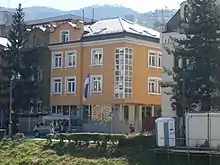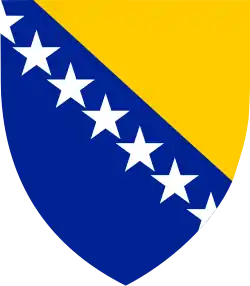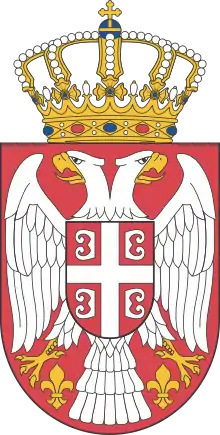Bosnia and Herzegovina–Serbia relations
Bosnian–Serbian relations are foreign relations between Bosnia and Herzegovina and Serbia. The modern-day countries both originated from Yugoslavia. The majority of population in both countries speak one of the standard varieties of Serbo-Croatian and Serbia is one of the largest investors in Bosnia and Herzegovina.
 | |
Bosnia and Herzegovina |
Serbia |
|---|---|
Bosnia and Herzegovina has an embassy in Belgrade. Serbia has an embassy in Sarajevo and a consulate-general in Banja Luka, Mostar, Trebinje, and Drvar. Both countries are full members of the Council of Europe, the Organization for Security and Co-operation in Europe (OSCE) and the Central European Free Trade Agreement (CEFTA). Serbia is an official candidate state for membership of the European Union and Bosnia is recognized as potential candidate country by the European Union.
Geography


The two countries are located in the western Balkans and Southeastern Europe. They share 357 km of land boundary, partly (206 km) along the Drina.
Yugoslavia
Bosnian War
2015
On July 8, 2015, Russia vetoed a United Nations Security Council resolution that would have condemned the Srebrenica massacre as a genocide. Lobbied by the Republika Srpska and Serbia, the veto was praised by Serbian President Tomislav Nikolić stating that Russia had "prevented an attempt of smearing the entire Serbian nation as genocidal" and proven itself as a true and honest friend.[1]
Invited by the Bosnian government to attend the annual Srebrenica Genocide Memorial, Serbian Prime Minister Aleksandar Vučić accepted, travelling to Srebrenica on 11 July 2015 to pay his respect. He was attacked by a mob in the crowd with stones, bottles and other objects and had to flee the premise.[2]
A planned memorial to the victims of the Operation Oluja was prohibited in Sarajevo.[3]
Economy
Serbia is the second top investor in Bosnia and Herzegovina, according to data spanning May 1994–December 2013.
Culture
Serbs and Bosniaks ethnolinguistically belong to the South Slavic peoples.
The majority of population in Serbia and Bosnia and Herzegovina speak Serbo-Croatian. One of its standard varieties, Serbian, is official in both countries. Bosnian and Croatian, the other varieties of Serbo-Croatian official in Bosnia and Herzegovina, are recognized as minority languages of Serbia.
Demographics
Serbs in Bosnia and Herzegovina
Serbs are one of the three constituent peoples of Bosnia and Herzegovina along with Bosniaks and Croats. They are the second largest ethnic group, numbering 1,086,733 (30.78%) according to the 2013 census. The community is concentrated in Republika Srpska (numbering 970,857; 82.95%), one of two entities making up BiH. Serbs are predominantly members of the Serbian Orthodox church.
Republika Srpska
The beginnings of formal cooperation can be traced to the Bosnian War; Republika Srpska got support from Serbia.[4] At the Dayton Agreement, the President of the Republic of Serbia Slobodan Milošević represented the Bosnian Serb interests due to absence of Radovan Karadžić. The agreement ensured the right for entities in Bosnia and Herzegovina to establish special parallel relationships with neighboring countries consistent with sovereignty and territorial integrity of Bosnia and Herzegovina. The agreement on Special Parallel Relations was signed on February 28, 1997 and implemented December 15, 2010.[5]
See also
References
- "Russia blocks U.N. condemnation of Srebrenica as a genocide". Reuters.
- "Serbia's president condemns 'savage' attack on PM at Srebrenica". The Guardian. 11 July 2015.
- "Sarajevo:Zabranjeno odavanje pošte žrtvama "Oluje"". B92.
- Judah. The Serbs. Yale University Press. pp. 222–224. ISBN 978-0-300-15826-7.
- "Archived copy". Archived from the original on 2011-08-15. Retrieved 2011-02-25.CS1 maint: archived copy as title (link)

